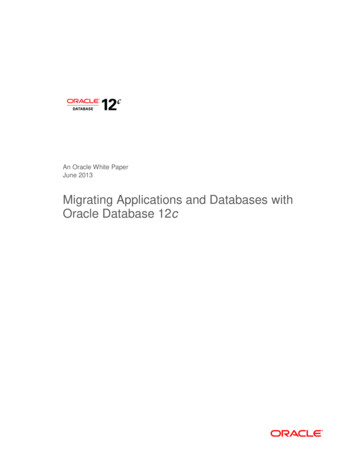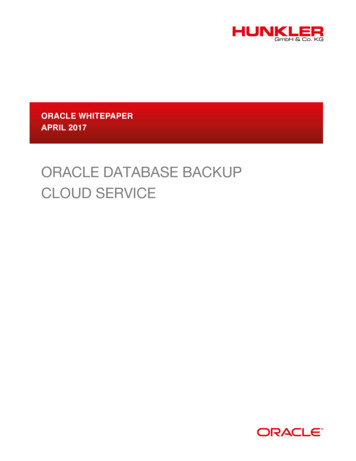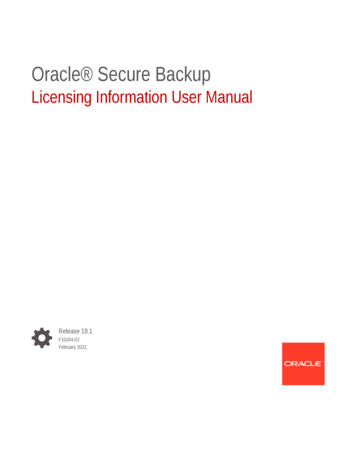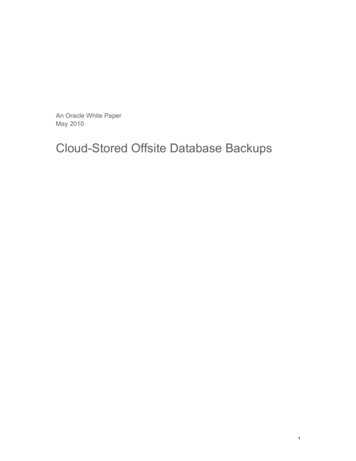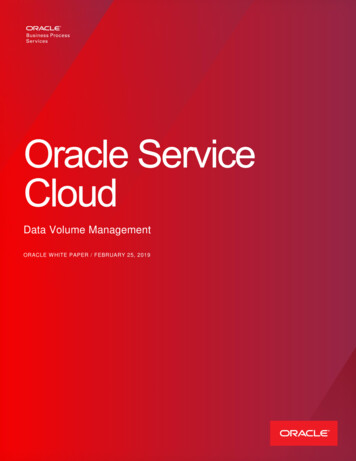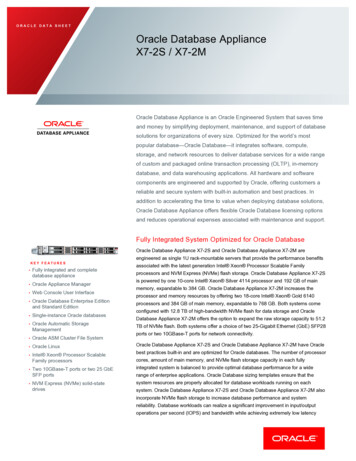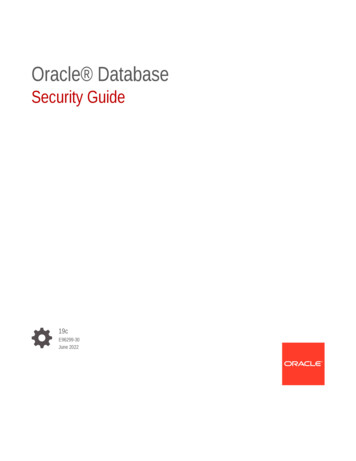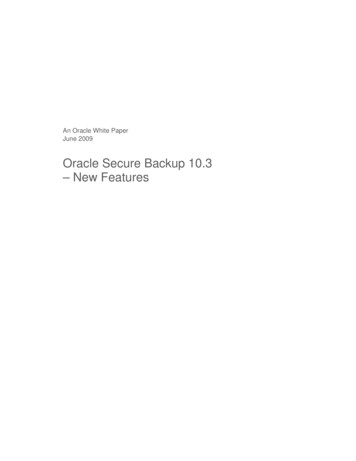
Transcription
Oracle CloudMigrating Oracle Database Backup CloudService Backups to Oracle CloudInfrastructureF22999-02June 2020
Oracle Cloud Migrating Oracle Database Backup Cloud Service Backups to Oracle Cloud Infrastructure,F22999-02Copyright 2019, 2020, Oracle and/or its affiliates.This software and related documentation are provided under a license agreement containing restrictions onuse and disclosure and are protected by intellectual property laws. Except as expressly permitted in yourlicense agreement or allowed by law, you may not use, copy, reproduce, translate, broadcast, modify,license, transmit, distribute, exhibit, perform, publish, or display any part, in any form, or by any means.Reverse engineering, disassembly, or decompilation of this software, unless required by law forinteroperability, is prohibited.The information contained herein is subject to change without notice and is not warranted to be error-free. Ifyou find any errors, please report them to us in writing.If this is software or related documentation that is delivered to the U.S. Government or anyone licensing it onbehalf of the U.S. Government, then the following notice is applicable:U.S. GOVERNMENT END USERS: Oracle programs (including any operating system, integrated software,any programs embedded, installed or activated on delivered hardware, and modifications of such programs)and Oracle computer documentation or other Oracle data delivered to or accessed by U.S. Government endusers are "commercial computer software" or “commercial computer software documentation” pursuant to theapplicable Federal Acquisition Regulation and agency-specific supplemental regulations. As such, the use,reproduction, duplication, release, display, disclosure, modification, preparation of derivative works, and/oradaptation of i) Oracle programs (including any operating system, integrated software, any programsembedded, installed or activated on delivered hardware, and modifications of such programs), ii) Oraclecomputer documentation and/or iii) other Oracle data, is subject to the rights and limitations specified in thelicense contained in the applicable contract. The terms governing the U.S. Government’s use of Oracle cloudservices are defined by the applicable contract for such services. No other rights are granted to the U.S.Government.This software or hardware is developed for general use in a variety of information management applications.It is not developed or intended for use in any inherently dangerous applications, including applications thatmay create a risk of personal injury. If you use this software or hardware in dangerous applications, then youshall be responsible to take all appropriate fail-safe, backup, redundancy, and other measures to ensure itssafe use. Oracle Corporation and its affiliates disclaim any liability for any damages caused by use of thissoftware or hardware in dangerous applications.Oracle and Java are registered trademarks of Oracle and/or its affiliates. Other names may be trademarks oftheir respective owners.Intel and Intel Inside are trademarks or registered trademarks of Intel Corporation. All SPARC trademarks areused under license and are trademarks or registered trademarks of SPARC International, Inc. AMD, Epyc,and the AMD logo are trademarks or registered trademarks of Advanced Micro Devices. UNIX is a registeredtrademark of The Open Group.This software or hardware and documentation may provide access to or information about content, products,and services from third parties. Oracle Corporation and its affiliates are not responsible for and expresslydisclaim all warranties of any kind with respect to third-party content, products, and services unless otherwiseset forth in an applicable agreement between you and Oracle. Oracle Corporation and its affiliates will not beresponsible for any loss, costs, or damages incurred due to your access to or use of third-party content,products, or services, except as set forth in an applicable agreement between you and Oracle.
ContentsPreface12AudiencevDocumentation AccessibilityvRelated ResourcesvConventionsviIntroduction to Migrating to Oracle Cloud InfrastructureWhy Migrate to Oracle Cloud Infrastructure1-1About Oracle Cloud Infrastructure1-1About the Migration Scope1-2About the Migration Task Flow1-2Prepare to Migrate Database BackupsGet Details of the Source Environment2-1Restore Backups from Archive Storage in Oracle Cloud Infrastructure ObjectStorage Classic2-1Set Up Your Target Environment2-2Install the Oracle Database Cloud Backup Module for OCIBefore You Begin Installing Oracle Database Cloud Backup Module for OCI2-3Parameters to Run the Oracle Database Cloud Backup Module for OCI2-4Downloading and Installing the Oracle Database Cloud Backup Module forOCI2-9Files Created when Oracle Database Cloud Backup Module for OCI isInstalledConfigure the Oracle Database Cloud Backup Module for OCIConsiderations for Migrating Data Using Rclone32-22-102-102-11Migrate Database Backups to Oracle Cloud Infrastructure ObjectStorageDownload and Install Rclone3-1Configure Your Environment3-1iii
Migrate Backups to Oracle Cloud Infrastructure Object Storage43-3Complete the Post-Migration StepsValidate the Migrated Backups4-1iv
PrefaceTopics: Audience Documentation Accessibility Related Resources ConventionsAudienceThis document is intended for users who are considering migrating their databasebackups, created using Oracle Database Backup Cloud Service, from Oracle CloudInfrastructure Object Storage Classic to Oracle Cloud Infrastructure Object Storage.Documentation AccessibilityFor information about Oracle's commitment to accessibility, visit the OracleAccessibility Program website at http://www.oracle.com/pls/topic/lookup?ctx acc&id docacc.Access to Oracle SupportOracle customers that have purchased support have access to electronic supportthrough My Oracle Support. For information, visit http://www.oracle.com/pls/topic/lookup?ctx acc&id info or visit http://www.oracle.com/pls/topic/lookup?ctx acc&id trsif you are hearing impaired.Related ResourcesFor more information, see these Oracle resources: Oracle Database Backup Cloud Service /db-backup-cloud/index.html Oracle Cloud Infrastructure ntent/home.htm Oracle Cloud Infrastructure Getting GSG/Concepts/baremetalintro.htm Oracle Cloud Infrastructure Object Storage Classic /storage-cloud/index.htmlv
Preface Upgrade to Oracle Cloud Infrastructure tmlConventionsThe following text conventions are used in this document:ConventionMeaningboldfaceBoldface type indicates graphical user interface elements associatedwith an action, or terms defined in text or the glossary.italicItalic type indicates book titles, emphasis, or placeholder variables forwhich you supply particular values.monospaceMonospace type indicates commands within a paragraph, URLs, codein examples, text that appears on the screen, or text that you enter.vi
1Introduction to Migrating to Oracle CloudInfrastructureLearn how to migrate backups of your on-premise database from Oracle CloudInfrastructure Object Storage Classic to Oracle Cloud Infrastructure Object Storage.Topics: Why Migrate to Oracle Cloud Infrastructure About Oracle Cloud Infrastructure About the Migration Scope About the Migration Task FlowWhy Migrate to Oracle Cloud InfrastructureOracle encourages you to migrate your existing cloud resources to Oracle CloudInfrastructure regions. You can gain several advantages by doing so.In Oracle Cloud, you provision resources in specific regions, which are localized togeographic locations. Certain regions support the Oracle Cloud Infrastructure platform.Oracle Cloud Infrastructure is Oracle's modern cloud platform that's based on thelatest cloud technologies and standards. It provides more consistent performance andbetter features at lower costs. Oracle continues to invest in Oracle CloudInfrastructure, including the addition of new regions, services, and features. See DataRegions for Platform and Infrastructure Services.You can benefit from these additional administrative features when you migrate yourcloud resources to Oracle Cloud Infrastructure: Organize cloud resources into a hierarchy of logical compartments. Create fine-grained access policies for each compartment.To learn more, see Upgrade Your Classic Services to Oracle Cloud Infrastructure.About Oracle Cloud InfrastructureGet familiar with basic Oracle Cloud Infrastructure security, network, and storageconcepts.Cloud resources in Oracle Cloud Infrastructure are created in logical compartments.You also create fine-grained policies to control access to the resources within acompartment.You create instances within an Oracle Cloud Infrastructure region. You also specify anavailability domain (AD), if supported in the selected region.1-1
Chapter 1About the Migration ScopeA virtual cloud network (VCN) is comprised of one or more subnets, and an instance isassigned to a specific subnet. Oracle Cloud Infrastructure does not allow you toreserve specific IP addresses for platform services.A subnet's security lists permit and block traffic to and from specific IP addresses andports.Instances can communicate with resources outside of Oracle Cloud by using OracleCloud Infrastructure FastConnect, which provides a fast, dedicated connection to youron-premises network. Alternatively, use an IPSec VPN.A bucket in Oracle Cloud Infrastructure Object Storage can be used to store files andshare them with multiple instances. A user's generated authentication token (authtoken) is required to access the bucket.To learn more, see Key Concepts and Terminology in the Oracle Cloud Infrastructuredocumentation.About the Migration ScopeLearn about the scope of migrating Oracle Database Backup Cloud Service to OracleCloud Infrastructure.When you use Database Backup Cloud Service to back up your on-premise databaseto Oracle Cloud Infrastructure Classic, the backups are stored in a container in OracleCloud Infrastructure Object Storage Classic. This guide describes how to migratethese backups from Oracle Cloud Infrastructure Object Storage Classic to OracleCloud Infrastructure. After migration, the backups are stored in a bucket in OracleCloud Infrastructure Object Storage.If your recovery window is long, and backups must be retained for a long time, it isbest to migrate backups using the information in this guide.If your recovery window is short, consider retaining existing backups on Oracle CloudInfrastructure Object Storage Classic and creating new backups to Oracle CloudInfrastructure. To do this, you install the Oracle Database Cloud Backup Module forOCI and create backups to a bucket in Oracle Cloud Infrastructure Object Storage.Ensure that the location of the credentials wallet and the name of the configuration fileare different from those used for the Oracle Database Cloud Backup Module for OCIClassic. If you need to restore backups stored on Oracle Cloud Infrastructure ObjectStorage Classic, allocate an RMAN channel that uses the confguration details of theOracle Database Cloud Backup Module for OCI Classic and then perform the restore.About the Migration Task FlowAt a high level, the migration process comprises these tasks.1.Prepare to migrate backups from Oracle Cloud Infrastructure Object StorageClassic to Oracle Cloud Infrastructure Object Storage. See Prepare to MigrateDatabase Backups.2.Migrate backups to Oracle Cloud Infrastructure Object Storage. See MigrateDatabase Backups to Oracle Cloud Infrastructure Object Storage.3.Perform post-migration tasks. See Complete the Post-Migration Steps.1-2
2Prepare to Migrate Database BackupsBefore you migrate Oracle Database Backup Cloud Service to Oracle CloudInfrastructure, plan and prepare for migration.Topics: Get Details of the Source Environment Restore Backups from Archive Storage in Oracle Cloud Infrastructure ObjectStorage Classic Set Up Your Target Environment Considerations for Migrating Data Using RcloneGet Details of the Source EnvironmentIdentify the user name, password, and REST Endpoint URL of the Oracle CloudInfrastructure Object Storage Classic account from which you want to migrate data.You can find out the user name and password from the New Account Informationemail that you received from Oracle Cloud when your account was set up. If you don'thave your New Account Information email, ask your account administrator for yourOracle Cloud user name and password.To identify the REST Endpoint URL:1.Sign in to your Oracle Cloud account.2.Open the navigation menu on the top left, select Classic Infrastructure Services,then Storage Classic.The Storage Classic page appears, with Containers as the current tab.3.Note the name of the container that contains the database backups that you needto migrate.4.Click the Account tab.Note down the REST Endpoint displayed in this page.Restore Backups from Archive Storage in Oracle CloudInfrastructure Object Storage ClassicDatabase backups that have been moved to an archive container in Oracle CloudInfrastructure Object Storage Classic must be restored before they can be migrated toOracle Cloud Infrastructure.To restore backups from an archive container:1.Sign in to your Oracle Cloud Infrastructure Object Storage Classic console.2-1
Chapter 2Set Up Your Target Environment2.Open the navigation menu on the left, select Classic Infrastructure Services,and then Storage Classic.3.Select the container that stores the archived database backups.4.Identify the archived object that you want to restore.5.Select Check Status.The Checking current status of archive object dialog box appears with thefollowing message:Currently the object is archived.See My Oracle Support Doc ID 2360800.1 at https://support.oracle.com forreporting on backups stored in Oracle Cloud Infrastructure Object Storage Classicwithout using Recovery Manager (RMAN).6.Select Restore to restore the archived object.The following message appears:Are you sure you want to restore the object objectName?7.Click OK.The following message appears:Restore job for objectName initiated successfully. You can check theRestore Status by clicking theCheck Status button.By default, the object remains restored for one day, after which you must restore itagain to be able to download it.8.Click OK.Set Up Your Target EnvironmentInstall and configure the Oracle Database Cloud Backup Module for OCI.Topics: Install the Oracle Database Cloud Backup Module for OCI Configure the Oracle Database Cloud Backup Module for OCIInstall the Oracle Database Cloud Backup Module for OCIUse the Oracle Database Cloud Backup Module for OCI to integrate RecoveryManager (RMAN) on your on-premise database with Oracle Cloud InfrastructureObject Storage.As part of the install, you also create bucket on Oracle Cloud Infrastructure ObjectStorage to store your migrated backups.2-2
Chapter 2Set Up Your Target EnvironmentTopics: Before You Begin Installing Oracle Database Cloud Backup Module for OCI Parameters to Run the Oracle Database Cloud Backup Module for OCI Downloading and Installing the Oracle Database Cloud Backup Module for OCI Files Created when Oracle Database Cloud Backup Module for OCI is InstalledBefore You Begin Installing Oracle Database Cloud Backup Module for OCIBefore you install the Oracle Database Cloud Backup Module for OCI, make sure youhave what you need: A supported Oracle Database version and operating systemSee Supported Databases and Operating Systems. An Oracle Technology Network (OTN) account or Oracle.com accountIf you don’t have an OTN account, create one by registering at http://www.oracle.com/technetwork/index.html. An Oracle Cloud account with access to Oracle Cloud Infrastructure ObjectStorageSee Object Storage in the Oracle Cloud Infrastructure Documentation. Oracle Cloud Infrastructure API signing keys, tenant OCID, and user OCIDYou may specify a compartment ID. However, if the compartment ID is notspecified, the tenant ID is used as the compartment ID.See Required Keys and OCIDs. JDK 1.7 or laterYou must have JDK 1.7 or later on the system on which you plan to install theOracle Database Cloud Backup Module for OCI. Use the following command tocheck your JDK version:java -version The required patch if you’re using the Standard Edition of Oracle DatabaseSee My Oracle Support Doc ID 1640149.1 at http://support.oracle.com. Values for the parameters required to run the installer for Oracle Database CloudBackup Module for OCIIt’s best to compile this information before you run the installer. See Parameters toRun the Oracle Database Cloud Backup Module for OCI.2-3
Chapter 2Set Up Your Target EnvironmentNote:If your database server has multiple Oracle homes, the Oracle DatabaseCloud Backup Module for OCI must be installed into each ORACLE HOME.Alternatively, you can copy the library file (libopc.so or oraopc.dll,depending on your operating system) to other Oracle home library locations,along with the opcSID.ora configuration file (assuming you're using the samecloud credentials for backing up all databases in the database server).Copy and rename the opcSID.ora file for each database instance you arebacking up to the cloud, where SID matches the SID for the databaseinstance.Parameters to Run the Oracle Database Cloud Backup Module for OCIYou must specify parameters and their values when you run the Oracle DatabaseCloud Backup Module for OCI installer. Parameters include the host name for theOracle Cloud Infrastructure account and the private key used to sign Oracle CloudInfrastructure API requests. It’s best to compile this information before you run theinstaller.The following example shows what you’ll need to provide:java -jar oci install.jar-host -pvtKeyFile oci private key -pubFingerPrint oci public fingerprint-uOCID user ocid -tOCID tenancy ocid-walletDir /wallet directory -libDir /library directoryThe following table lists required parameters. Optional parameters are also listed.Parameters can also be displayed by running the following command from thedirectory that contains the oci install.jar installer file:java -jar oci install.jarParameterDescriptionRequired or Optional-hostEnd point of the Oracle CloudInfrastructure account.Required-pvtKeyFileFile that contains the privatekey used to authenticateOracle Cloud InfrastructureAPI requests. The key filemust be in PEM format.RequiredThis private key is nevertransmitted outside of thecomputer where the installer isrun.2-4
Chapter 2Set Up Your Target EnvironmentParameterDescriptionRequired or Optional-pubFingerPrintFinger print of the public keyRequiredpaired with the specifiedprivate key. The finger printtells Oracle CloudInfrastructure which privateand public key pair is used toauthenticate the API requests.-tOCIDTenancy OCID for the OracleCloud Infrastructure account.Required-uOCIDUser OCID for the OracleCloud Infrastructure account.Required-bucketName of the bucket in whichOptionalbackups are stored. If thisbucket does not exist, then theinstaller creates it.When this parameter isomitted, a default bucket isautomatically created to storebackups.-cOCIDResource compartment ID forthe Oracle CloudInfrastructure account. Thedefault value is the tenancyOCID if not specified.Optional-newRSAKeyPairSet up a new pair of publicOptionaland private RSA keys forauthentication. If specified, theinstaller generates a randomRSA private and public keypair of 2048 bits and storesthem in the specified Oraclewallet directory.-walletDirDirectory in which OracleCloud Infrastructure ObjectStorage credentials arestored.RequiredSuggested location on Linuxand UNIX systems:ORACLE HOME/dbs/opc walletSuggested location onWindows systems:ORACLE HOME\database\opc walletIf the specified wallet directorydoes not exist (for example,opc wallet), the installercreates it.2-5
Chapter 2Set Up Your Target EnvironmentParameterDescriptionRequired or Optional-libDirDirectory in which the systembackup to tape (SBT) libraryused for backups and restoreswith Oracle CloudInfrastructure is stored.Required if you want todownload the latest moduleOptional if you just want toupdate the password after youchange it in Oracle CloudIf omitted, the library is notdownloaded. In most cases,you should specify thisparameter and download thelibrary. An exception might beif you’re using the installer toregenerate the wallet andconfiguration file in an Oraclehome directory where theOracle Database CloudBackup Module for OCI waspreviously installed.Suggested location on Linuxand UNIX systems:ORACLE HOME/libSuggested location onWindows systems:ORACLE HOME\binIf the specified directory doesnot exist, you are prompted tocreate it and then run theinstaller again.2-6
Chapter 2Set Up Your Target EnvironmentParameterDescriptionRequired or Optional-libPlatformOperating system for the SBTlibrary used for backups andrestores.OptionalIn most cases, you don’t needto specify this parameterbecause the installerautomatically determines thecorrect operating system.Exceptions might be if you seeerror messages indicatingyour operating system can’t beidentified or if you need todownload the library for useon a different system.Supported values for thisparameter: linux64 windows64 solaris sparc64 solaris x64 zlinux64 hpux ia64 aix ppc64For information aboutsupported operating systems,see Supported Databases andOperating Systems.-lib-download-onlyDownloads only the SBTlibrary. Use this parameter toupdate the library withoutmaking changes to theconfiguration file and thewallet.Optional-configFileDirectory in which the Oracle OptionalDatabase Cloud BackupModule for OCI configurationfile is stored. If omitted, theconfiguration file is stored in adefault location.Default location on Linux andUNIX systems:ORACLE HOME/dbsDefault location on Windowssystems:ORACLE HOME\databaseThe file name isopc2SID.ora, where SID isthe system identifier of theOracle database being backedup to Oracle CloudInfrastructure Object StorageService.2-7
Chapter 2Set Up Your Target EnvironmentParameterDescriptionRequired or Optional-trustedCertsComma-separated list of SSL Optionalcertificates that must be addedto the wallet. If the installer isunable to retrieve thecertificates required for theSSL connection from localJava truststore, this SSLcertificates specified by thisparameter are imported. AllSSL certificates must be in thePEM format.-import-all-trustcertsImport all X509 certificatesfrom the Java truststore.-proxyHostHTTP proxy server host name Optional-proxyPortHTTP proxy server portnumberOptional-proxyIdHTTP proxy server username, if neededOptional-proxyPassHTTP proxy server password, Optionalif needed-argFileIndicates that parametersshould be read from thespecified file. For example, afile named arguments.txtmight contain the ny.com'-opcPass 'abc123 '-host libDir /home/oracle/OPC/lib-walletDir /home/oracle/OPC/walletFor this example, the followingcommand installs the OracleDatabase Cloud BackupModule for OCI using theparameters specified in thefile:java -jaropc2 install.jar argFile arguments.txt2-8
Chapter 2Set Up Your Target EnvironmentDownloading and Installing the Oracle Database Cloud Backup Module for OCIDownload and install the Oracle Database Cloud Backup Module for OCI on yourdatabase server.First, make sure you’re ready. See Before You Begin Installing Oracle Database CloudBackup Module for OCI.To download and install the Oracle Database Cloud Backup Module for OCI:1.Download the Oracle Database Cloud Backup Module for OCI from OracleTechnology Network vailability/oracle-cloudbackup-2162729.htmlAccept the license agreement, click All Supported Platforms, and provide yourOTN user name and password when prompted. Then download the ZIP file thatcontains the installer (opc installer.zip) to your system.2.Extract the contents of the zip file.The file contains two directories, oci installer and opc installer, and aREADME file.3.Run the installer, oci install.jar, from the oci installer directory. Provide therequired parameters in one line, with each parameter preceded by a hyphen andfollowed by its value. For information about required parameters, see Parametersto Run the Oracle Database Cloud Backup Module for OCI.The following is an example run of the installer. This example shows how the installerautomatically downloads the Oracle Database Cloud Backup Module for OCI for youroperating system, creates a wallet that contains Oracle Database Backup CloudService identifiers and credentials, creates the backup module configuration file, anddownloads the library necessary for backups and restores to Oracle CloudInfrastructure.% java -jar oci install.jar -host -pvtKeyFile /oracle/dbs/oci wallet/oci pvt-pubFingerPrint 7q4wdr2ka-walletDir /oracle/dbs/oci wallet-libDir /oracle/lib-bucket db backupsOracle Database Cloud Backup Module Install Tool, build 2018-12-11Oracle Database Cloud Backup Module credentials are valid.Backups would be sent to bucket db backups.Oracle Database Cloud Backup Module wallet created in directory /oracle/dbs/oci wallet.Oracle Database Cloud Backup Module initialization file /oracle/dbs/opcb18test.oracreated.Downloading Oracle Database Cloud Backup Module Software Library from fileopc linux64.zip.Download complete.2-9
Chapter 2Set Up Your Target EnvironmentFiles Created when Oracle Database Cloud Backup Module for OCI is InstalledAfter you run the installer for the Oracle Database Cloud Backup Module for OCI,make sure the required files are on your system.The following files are created when you install the backup module and they are usedto perform cloud backups and restores. For information about the parametersmentioned, see Parameters to Run the Oracle Database Cloud Backup Module forOCI.FileLocationPurposelibopc.so on Linux andUNIX systemsAs specified for the —libDirparameter when you run theinstaller for the OracleDatabase Cloud BackupModule for OCI.Operating system-specificSBT library that enables cloudbackups and restores with theOracle Cloud Infrastructure.oraopc.dll on WindowssystemsExample location:ORACLE HOME/libopcSID.oraAs specified for the —configFile parameter whenyou run the installer for theOracle Database CloudBackup Module for OCI.Default location on Linux andUNIX systems:ORACLE HOME/dbsConfiguration file that containstheOracle Cloud InfrastructureObject Storage bucket URLand credential wallet location,where SID is the systemidentifier of the Oracledatabase being backed up toOracle Cloud Infrastructure.Default location on Windowssystems:ORACLE HOME\databasecwallet.ssoAs specified for the —walletDir parameter whenyou run the Oracle DatabaseCloud Backup Module for OCIinstaller.Example location:ORACLE HOME/dbs/opc walletOracle wallet file that securelystores Oracle CloudInfrastructure Object Storagecredentials. This file is usedduring Recovery Manager(RMAN) backup and restoreoperations and is stored in theOracle Cloud InfrastructureObject Storage wallet directory(for example, opc wallet).Configure the Oracle Database Cloud Backup Module for OCIConfigure an RMAN channel to integrate your on-premise database with Oracle CloudInfrastructure Object Storage.To configure an RMAN channel that corresponds to the Oracle Database CloudBackup Module for OCI:1.Start RMAN on your on-premise database and connect to the target database.2-10
Chapter 2Considerations for Migrating Data Using RcloneThe following example connects to your target database by using operatingsystem authentication:% rman target /The following example connects to your target database, with DBID prod, by usingpassword file authentication. Enter the password for the bkup admin user (with theSYSBACKUP privileges) when prompted.% rman target "bkup admin@prod as sysbackup"2.Use the RMAN CONFIGURE command to configure a channel that corresponds tothe Oracle Database Cloud Backup Module for OCI.The RMAN channel configuration must use the path to the backup module's libraryand configuration files created when you installed the Oracle Database CloudBackup Module for OCI. Once channel configuration is complete, you are ready touse RMAN commands to work with Oracle Cloud Infrastructure Object Storage.Example 2-1Configuring RMAN to Back Up to Oracle Cloud InfrastructureOn Linux and UNIX systems, the following command configures an RMAN channelthat uses the Oracle Database Cloud Backup Module for OCI SBT library for backupand restore operations to Oracle Cloud Infrastructure:RMAN CONFIGURE CHANNEL DEVICE TYPE sbtPARMS 'SBT LIBRARY OCI,SBT PARMS (OPC PFILE location-of-the-configuration file)';For example:RMAN CONFIGURE CHANNEL DEVICE TYPE sbtPARMS 'SBT LIBRARY /orclhome/lib/libopc.so,SBT PARMS (OPC PFILE /orclhome/dbs/opcora12.ora)';On Windows systems, you’ll need to specify the ENV parameter. For example:RMAN CONFIGURE CHANNEL DEVICE TYPE sbtPARMS 'SBT LIBRARY C:\tmp\oraopc.dll,ENV (OPC PFILE C:\tmp\opcora12.ora)';Note:If you have existing backups on Oracle Cloud Infrastructure, ensure that thebackup piece names are not the same as the ones in Oracle CloudInfrastructure Object Storage Classic. This is to avoid the risk of overwritingobjects in the target bucket. It is recommended that you use the format ''%d%U' when creating the backups to avoid such conflicts.Considerations fo
Oracle Database Cloud Backup Module for OCI Classic and then perform the restore. About the Migration Task Flow At a high level, the migration process comprises these tasks. 1. Prepare to migrate backups from Oracle Cloud Infrastructure Object Storage
